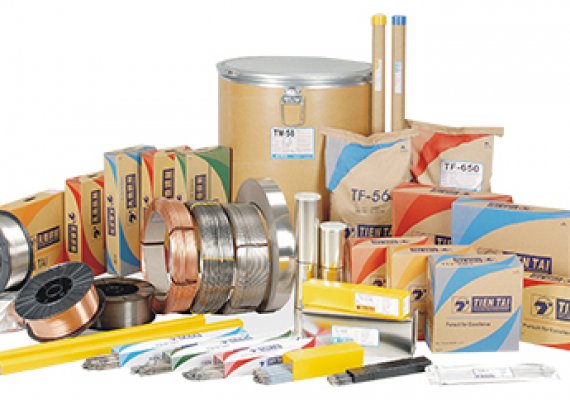Q1:What is welding material? What is included?
A: Welding consumables refer to the general term for materials consumed during welding. Including electrodes, wires, fluxes, gases, electrodes, gaskets, etc.


Q2:What is welding wire?
A: When welding, it is used as a filler metal and a wire used to conduct electricity at the same time – called welding wire. There are two types of solid wire and flux-cored wire. Commonly used solid wire model: (GB national standard) ER50-6 (brand: H08Mn2SiA). (AWS American Standard) ER70-6.
Q3:Why are MAG welded joints higher impact toughness than CO2 welded joints?
A: During MAG welding, the active gas is only 20%, the alloying element transition coefficient in the welding wire is high, and the impact toughness of the weld is high.
The active gas of CO2 welding is 100%, the manganese and silicon alloy elements in the welding wire are combined with deoxidation, the transition coefficient of the alloy elements is slightly lower, and the impact toughness of the weld is not as high as that of MAG welding.
Such as Kobelco MG-51T welding wire (equivalent to ER50-6), its room temperature impact toughness value: MAG welding: 160J; CO2 welding: 110J.
Q4:What flux-cored wire?
A: It is a kind of welding wire that is drawn from a thin steel strip rolled into a round steel pipe and filled with a certain composition of powder at the same time.
Q5:Why is flux-cored wire shielded with CO2 gas?
A: There are four types of flux-cored welding wire: acid flux-cored gas-shielded welding wire (titanium type), basic flux-cored gas-shielded welding wire (titanium-calcium type), metal powder-type flux-cored gas-shielded welding wire, and flux-cored self-shielded welding wire.
Domestic titanium flux-cored gas shielded welding wire is generally protected by CO2 gas; other flux-cored welding wires are protected by mixed gas (please refer to the specification of the flux-cored welding wire). gas.
Combined protection of flux-cored wire and gas slag, good weld formation, and high comprehensive mechanical properties.
Q6:Why do indentation pores appear on the surface of flux-cored wire welds?
A: Because the flux-cored welding wire is a tubular welding wire rolled from a thin steel strip, it is a seamed welding wire; the moisture in the air will penetrate into the flux core through the gap, and the welding flux is wet (cannot be dried), resulting in indentation pores in the weld.


Q7:Why are there technical requirements for CO2 gas purity?
A: Generally, CO2 gas is a by-product of chemical production, and its purity is only about 99.6%. It contains trace impurities and moisture, which will bring defects such as pores to the weld. Welding important products must use gas with CO2 purity ≥99.8%, fewer pores in the weld, low hydrogen content, and good crack resistance.
Q8:Why does the purity of argon have higher technical requirements?
A: At present, there are three kinds of argon on the market: ordinary argon (purity of about 99.6%), pure argon (purity of about 99.9%), high-purity argon (purity of 99.99%), the first two can weld carbon steel and stainless steel.
High-purity argon must be used for welding non-ferrous metals such as aluminum and aluminum alloys, titanium and titanium alloys; to avoid oxidation of welds and heat-affected zones, high-quality and beautiful weld formation cannot be obtained.
Q9:Why are TIG welding nozzles available in various sizes?
A: There are various specifications of nozzles, 4-5﹟ nozzles can be selected for welding carbon steel, and 6-7﹟ large nozzles should be used for welding stainless steel and aluminum and aluminum alloys to strengthen the protection range of welds and heat-affected zones. When welding non-ferrous metals such as titanium and titanium alloys, 7-8﹟ larger nozzles should be used to prevent the weld and heat-affected zone from being oxidized.


Q10:What is an acid electrode?
A: Electrodes containing a large number of acid oxides in the coating, such as junction 422 (E4303), junction 502 (E5003), and other AC and DC electrodes.
Q11:What is an alkaline electrode?
A: The coating contains a lot of alkaline oxides and fluoride electrodes, such as junction 507 (E5015), junction 506 (E5016), and other electrodes.
Q12:What are cellulose type (for downward vertical welding) electrodes?
A: Electrodes containing a large number of organic substances in the coating are specially used for downward vertical welding of pipelines and thin-plate structures.
<1> For example, E6010 (equivalent to E4310, J425G) is suitable for backing welding, thermal welding, and filling welding.
<2> E8010 (equivalent to E5511, J555) is suitable for thermal welding, filling welding, and cover welding.
Generally, low hydrogen down electrode is used for cover welding; E7048 (equivalent to J506X) weld appearance is neat and beautiful.
Q13:Why should the electrode be dried strictly before welding?
A: The welding rod often deteriorates the process performance due to moisture absorption, resulting in an unstable arc, increased spatter, and prone to defects such as pores and cracks.
Therefore, the electrode must be dried strictly before use. Generally, the drying temperature of the acid electrode is 150–200 ℃ and the time is 1 hour; the drying temperature of the alkaline electrode is 350–400 ℃, and the drying time is 1–2 hours. After drying, put it in an incubator of 100–150 ℃ Inside, take it as you go.
Like this page? Share it with your friends!


